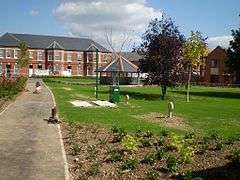Park Prewett Hospital
| Park Prewett Hospital | |
|---|---|
 A view of the redeveloped Park Prewett Hospital buildings. Now used for housing in Rooksdown. | |
| Geography | |
| Location | Basingstoke, Hampshire, England, United Kingdom |
| Organisation | |
| Care system | Public NHS |
| Hospital type | Psychiatric |
| Services | |
| Beds | 1000 |
| History | |
| Founded | 1917 |
| Closed | 1997 |
| Links | |
| Lists | Hospitals in England |
Park Prewett Hospital, also known as Park Prewett Mental Hospital,[1] was a psychiatric hospital northwest of Basingstoke, in the county of Hampshire in England, which operated from 1917 until 1997. The hospital was designed by the noted asylum architect George T. Hine. It is the unnamed setting for the novel "Poison in the Shade" (1953) by the local author and sculptor Eric Benfield, who was working as an art therapist at the mental hospital.
Site
The land on which Park Prewett Hospital stands was originally part of the Park Prewett Farm. Park Prewett [Prevet] was an enclosure dating back to the time of Edward I.[2] The Farm occupied a triangle bounded to the south by the A339, to the east by the A340 and on the north west by Rooksdown Lane, the old Roman road.
Plans
Following a report by the Lunacy Commission into overcrowding at Knowle Hospital in the south of the county, a new site was required to house the expanding population. Park Prewett Farm was then acquired in 1899 and plans drawn up by Hine's firm, Hine and Pegg. The scheme was then postponed as the number of patients at Knowle Hospital had declined.
Construction
In 1910, it was agreed that building work would start at Park Prewett in 1912. Work was well advanced by 1914 when war broke out. Due to the intervention of World War I, labour was short, but it was completed in 1917.
Use

The building was first used by the Canadians as a military convalescent hospital until 1919 - It was known as ‘Number Four Canadian General Hospital’. Park Prewett opened as a mental hospital in 1921 and by 1936 catered for 1,400 patients. The hospital returned to military use again during World War II. Part of the hospital - Rooksdown House - was used by Sir Harold Gillies, the pioneering plastic surgeon. It was originally the private wing of the Asylum but became a plastic surgery unit in 1940.[3]
Railway line
The hospital was served by its own railway line from 1913 until 1954 from a junction on the South Western Main Line 1 mile (1.6 km) west of Basingstoke railway station.[4]
After closure
The hospital boundary was planted with a double row of trees forming a series of avenues with footpaths along the middle. This shelter belt is largely intact and shows the extent of the old hospital grounds.
In the late 1990s, after the hospital was abandoned it was sometimes put to other uses: The hospital's hall was used as a rave venue.
Park Prewett was bought by English Partnerships in 2005. They have licensed developers Taylor Woodrow for most new building on the site, and Thomas Homes for conversion of many of the old hospital blocks into housing and community facilities. The new housing development was called "Limes Park" and formed the core of a new civil parish named Rooksdown.
References
- ↑ The National Archives - Hospital Records Database. "Park Prewett Hospital, Basingstoke". Retrieved 2010-09-17.
- ↑ A History of the County of Hampshire: Volume 4 (1911). "Parishes - Sherborne St. John - British History Online". Retrieved 2010-09-17.
- ↑ Facial Plast Surg. 1 (2): 142–143. 1999 http://archfaci.ama-assn.org/cgi/content/extract/1/2/142. Missing or empty
|title=(help) - ↑ Hampshire County Council (2008-06-13). "The Railways of Hampshire". Retrieved 2008-10-11.
External links
| Wikimedia Commons has media related to Park Prewett Hospital. |
- Photographic tour of an abandoned institution.
- Urban Desertion: Park Prewett
- Photos and a History of Park Prewett
- Basingstoke Council: Park Prewett
- Rooksdown Parish Council - Park Prewett
- Thomas Homes
- Google map showing route of the Park Prewett railway
Coordinates: 51°16′49″N 1°07′09″W / 51.2803°N 1.1191°W